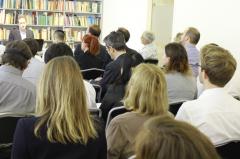New wiiw forecast for Central, East and Southeast Europe: Investment to the Rescue
03 July 2014
wiiw expects an acceleration of GDP growth in Central, East and Southeast Europe to an average 2-3% annually until 2016. A major driving force is an upward reversal of investments.

Dr. Mario Holzner, wiiw Deputy Director; photo © wiiw
First quarter 2014 results seem to support previous expectations of investment-led growth in Central, East and Southeast Europe (CESEE) countries that were widely based on anecdotal evidence. However, the development is quite diverse across major regions, some of which had to experience setbacks more recently.
Starting with the setbacks, the ongoing Russia-Ukraine conflict has negatively affected economic dynamics not only in these two countries but also in the three Baltic States that are both directly and indirectly dependent on Russia. Ukraine is expected to suffer a 5% decline in GDP in 2014, mostly on account of strongly falling investment. Russia and Estonia can hope for not much more than about half a percentage point of growth in 2014. With close to 3%, the growth forecast for Latvia and Lithuania is much better. However, as compared to the wiiw forecast of March this year we had to reduce the 2014 GDP growth outlook for these five countries on average by 1.8 percentage points.
Parts of the Western Balkans were hit hard by floods in May this year. In particular, Serbia and Bosnia and Herzegovina suffered huge damages due to rainfalls that were the heaviest in 120 years of recorded weather history. A number of these countries are pursuing, for different reasons, fiscal austerity (Albania, Croatia, Serbia, Kosovo), which also has negative effects on economic growth.
Hence the economies of Serbia, Croatia and Bosnia and Herzegovina will most likely be in recession or near stagnation in 2014. Growth in Albania, Montenegro, Macedonia and Kosovo will be more robust but mostly below previous expectations. On average, the wiiw growth forecast revision for the Western Balkans in 2014 is at -0.5% as compared to the wiiw Spring Forecast Report.
In the core new EU Member States additional efforts were made to raise the absorption rate of the funds allocated within the context of the EU multiannual financial framework for 2007-2013 that was about to come to a close by the end of last year. Over the remaining disbursement period of the biennium 2014-2015, substantially higher amounts of EU co-financed public investment – that has the potential to spur subsequent private investment – are to be expected. Indeed, investment activity picked up throughout most of the core new Member States in the first quarter of 2014. Also, improving growth prospects in the euro area are supporting export industries' activities. Growth rates for this group of countries are expected to range around 2% to 3% for 2014 (except for Slovenia, 0.5% and Bulgaria, 1.4%) with an average upward forecast revision of 0.6% as compared to our projections earlier this year.
Press Releases
Related Presentations
- Investment to the Rescue (press conference presentation in English)
- Investment to the Rescue (press conference presentation in German)

